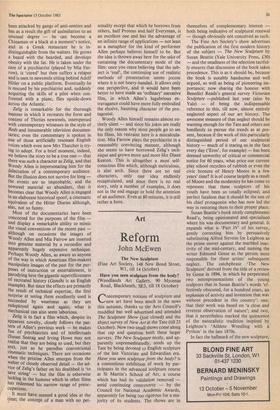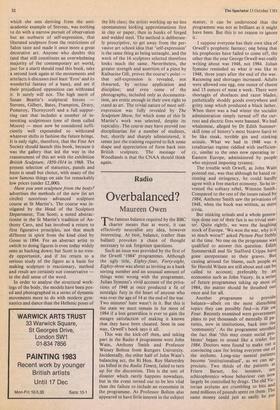Art
Reform
John McEwen
The New Sculpture (Fine Art Society, 148 New Bond Street, WI, till 14 October)
Have you seen sculpture from the body? (Woodlands Art Gallery, 90 Mycenae Road, Blackheath, SE3, till 18 October) Contemporary notions of sculpture and new art have been much in the news this autumn, thanks to the Arts Council's muddled but well advertised and attended The Sculpture Show (just closed) and the abject survey of New Art at the Tate (till 23 October). Now two small shows come along that cap and question both these larger surveys. The New Sculpture nicely, and ap- parently unpremeditatedly, sends up the Tate by being devoted to English sculpture of the late Victorian and Edwardian era. Have you seen sculpture from the body? is a contentious exhibition of work by par- ticipants in the advanced sculpture course at St Martin's School of Art, a course which has had its validation removed — amid continuing controversy — by the Council for National Academic Awards, apparently for being too rigorous for a ma- jority of its students. The shows are in
themselves of complementary interest — both being indicative of sculptural renewal — though obviously not conceived as such.
The Fine Art Society's show advertises the publication of the first modern history of the subject — The New Sculpture by Susan Beattie (Yale University Press, £30) — and the smallness of the selection tactful- ly ensures that discussion of the book takes precedence. This is as it should be, because the book is notably handsome and well argued, as well as being of pioneering im- portance; now sharing the honour with Benedict Reads's general survey Victorian Sculpture —published last year (also by Yale) — of being the indispensable reference to this, till now, almost entirely neglected aspect of our art history. The awesome measure of that neglect should be warning enough for the Tate and others not heedlessly to pursue the trends as at pre- sent, because if the work of this particularly distinguished period of our sculptural history — much of it staring us in the face every day (`Eros', for example) — has been deemed unworthy of critical or commercial notice for 60 years, what price our current play school recyclers of rubbish or even the civic bronzes of Henry Moore in a few years' time? It is of course largely as a result of Moore and the modernity he has come to represent that these sculptors of his youth have been so totally eclipsed; and perfect fatalism that it should be the son of his chief protagonist who has now led the way in restoring them to their proper place.
Susan Beattie's book nicely complements Read's, being opinionated and specialised where his was documentary and general. It expands what is 'Part IV' of his survey, gently correcting him by persuasively substituting Alfred Stevens for Leighton as the prime mover against the marbled inac- tivity of the mid-century, and naming the writer Edmund Gosse as the person most responsible for these artists' subsequent neglect. The catchphrase 'The New Sculpture' derived from the title of a review by Gosse in 1894, in which he perpetrated two misrepresentations of the young sculptors that in Susan Beattie's words 'ef- fectively obscured, for a hundred years, an explosion of activity and invention that was without precedent in this country': one, that their work was based on 'a close and reverent observation of nature'; and two, that it nevertheless marked the quiescence of the naturalistic tradition inspired by Leighton's 'Athlete Wrestling with a Python' in the late 1870s.
In fact the hallmark of the new sculpture,
which she sees deriving from the anti- academic example of Stevens, was nothing to do with a narrow pursuit of observation but an outburst of self-expression, that liberated sculpture from the restrictions of Salon taste and made it once more a great decorative art. Anyone who doubts this (and that still constitutes an overwhelming majority of the contemporary art world, just for a start) should read this book, take a second look again at the monuments and artefacts it discusses (not least 'Eros' and its wonderful fantasy of a base), and see if their prejudiced opposition can withstand it. It surely will not. The high merit of Susan Beattie's sculptural heroes — Stevens, Gilbert, Bates, Frampton, Drury, Pomeroy, Thornycroft and a full suppor- ting cast that includes a number of in- teresting sculptresses (one of them called Moore) — must now be considered suffi- ciently well expounded to withstand whatever shifts in fashion the future brings. It is only right, therefore, that the Fine Art Society should launch this book, because it was the gallery that led the way in the reassessment of this art with the exhibition British Sculpture, 1850-1914 in 1968. The present selection of statuettes, panels and busts is small but choice, with many of the now famous things on sale for remarkably low prices (under £2,000).
Have you seen sculpture from the body? advertises the methods of the now (in art circles) notorious advanced sculpture course at St Martin's. The course was in- stigated by the Head of the Sculpture Department, Tim Scott, a noted abstrac- tionist in the St Martin's tradition of An- thony Caro, and has involved a return to first figurative principles, not that much different in spirit from the kind cited by Gosse in 1894. For an abstract artist to switch to doing figures is even today widely seen as backing down; but Scott is no tren- dy opportunist, and if his return to a serious study of the figure as a basis for making sculpture is reactionary, method and result are certainly not conservative — in the dull sense of the word.
In order to analyse the structural work- ings of the body, the models have been pos- ed and photographed in a series of dynamic movements more to do with modern gym- nastics and dance than the Hellenic poses of
the life class; the artists working up no less spontaneous looking approximations first in clay or paper, then in hunks of forged and welded steel. The method is deliberate- ly prescriptive, to get away from the per- vasive art school idea that 'self-expression' is the same thing as being untaught, and the work of the 16 sculptors selected therefore looks much the same. Nevertheless, the greater strength and assertion of a piece by Katharine Gili, proves the course's point — that self-expression is revealed, not thwarted, by serious application and discipline; and even some of the photographs, included only as documenta- tion, are erotic enough in their own right to ,stand as art. The trivial nature of most self- expression was fully revealed by The Sculpture Show, for which none of this St Martin's work was selected, despite its topicality. The course may have proved too disciplinarian for a number of students, but, shortly and sharply administered, it seems just the training required to lick some shape and appreciation of form back into British sculpture. The message of Woodlands is that the CNAA should think again.











































 Previous page
Previous page